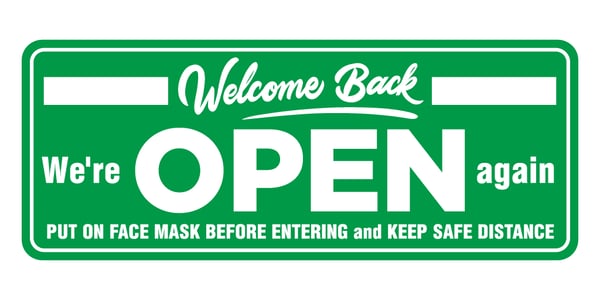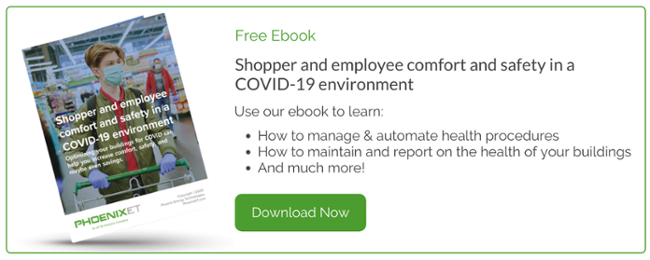Shopper and Employee Comfort and Safety In a COVID-19 Environment

Even before the crippling Coronavirus pandemic, there has been a push to get buildings healthy. Multiple research groups have backed decades of scientific studies that prove healthy buildings reap stronger performance from employees, with costs for implementation offset by increased worker productivity, and in some cases, lower energy costs.
Healthier building environments lead to better staff cognitive function, fewer sick days, and less sick building syndrome incidents. It can also limit harmful outside particulate matter, which WHO claims contributes to 800,000 premature deaths annually. Providing better human health performance does not need to break the bank in capital expenditures and operating expenses. A National Institute of Standards and Technology study found some strategies support both better indoor air quality and energy efficiency strategies that include "envelope airtightness, heat recovery ventilation, demand-controlled ventilation, and improved system maintenance."
Now enter COVID, which has added its influence on the need for buildings to be as safe and healthy as possible.
Interestingly, retail building managers can usually rely on commercial trends to learn what building technologies and best practices will trend in the following years; however, COVID is really hitting retail first. Retail owners and managers have some specific challenges right now, including:
- Chains worrying about being known as a "site for COVID" should someone fall ill due to shopping in their store–the potential negative brand impact affecting shopping at multiple locations is a harrowing threat.
- The cost involved replacing HVAC filters at all locations as a safety precaution and maintaining a reputation as doing everything possible to protect customers and employees.
- Capturing long-term building data to ensure proof of compliance with standards and recommendations should any legal issues come up.
Listen to the recording: PetSmart occupied setpoints during COVID webinar.
COVID Building Compliance
There are many recommendations as buildings reopen, but no real mandates. In most buildings, "the only regulations that apply are worker safety and public health requirements," such as reducing building occupants allowed in a space. Facility managers must decide where to focus attention based on where the science and top authorities are emphasizing safety. And science is increasingly focusing on air quality. Ventilation may be a way to create and maintain healthier indoor environments.
The EPA indicates that COVID air transmission is "active research that is fast developing" and that:
"The relative importance of (reducing COVID air transmission indoors) has not been established at this point. (The) increasing weight of evidence supports the use of precautions against transmission of SARS-Co-V-2 in indoor environments as an addition to other measures already known to limit it."
The EPA states that there is growing evidence being brought forth, including:
- Reports of measurement of the virus in the air, including beyond the distance recommended for droplet transmission
- Physically-based models of emissions of virus-laden aerosols and their dynamics
- Evidence of airborne transmission for the closely-related coronaviruses that caused the SARS and MERS outbreaks
- Epidemiological evidence suggestive of possible airborne transmission, though other routes cannot be excluded.
HVAC Systems
Given where the science is heading, there could be new regulations that facility managers need to increase ventilation and monitor airflow, humidity, unit efficiency and system recommissioning, and amount and quality of outside air brought indoors.
Deborah Bennet, a public health professor at UC Davis, says many buildings will have difficulty increasing overall ventilation. She says, "commercial buildings don't always have ventilation that meets code, and even when they do, the code is set to require a minimal air exchange rate". A minimal rate may not be enough to reduce the coronavirus spread, although Bennet says bringing in more outdoor air into indoor spaces can help.
Harvard's Joseph Allen, co-author of Healthy Buildings: How Indoor Spaces Drive Performance and Productivity, says, "There’s no such thing as zero risk in anything we do, certainly not during a pandemic. But if you layer enough of these control strategies on top of each other, you can significantly reduce risk."
WHO has contributed to ventilation guidance that claims that:
"If the air conditioning or ventilation system is not well maintained and operated, there are two potential mechanisms through which it could contribute to virus transmission. The system itself could recirculate contaminated air; and/or could create indoor conditions (temperature and humidity) that support virus survival.
If a ventilation system is well maintained and operated the risk of transmission should not be significant in either residential or commercial buildings. Thus, an important prevention measure is to have all air conditioning and industrial ventilation systems for both residential and high occupancy buildings (government buildings, schools, hotels, and hospitals) inspected, maintained, and cleaned regularly."
The following are top industry recommendations and best practices to consider in managing HVAC systems and locations generally as retail doors reopen.
Recommendations & Best Practices
ASHRAE Air Quality & Water Recommendations
With the science on COVID trending toward keeping airborne transmission down as much as possible, retailers should consider enhanced ventilation measures.
ASHRAE has put out several COVID-19 resources on HVAC's safe operation and building water management systems.
ASHRAE's detailed list includes advice such as:
- Establish a reopening plan that focuses on occupants' health and well-being, with PPE, communications, and safety measures outlined
- Follow HVAC guidance of flushing two hours before and after a building is occupied, including operating exhaust fans and opening outside air dampers.
- Make use of windows to flush air for two hours before occupancy, where a building cannot treat large quantities of outside air.
- Follow EPA and CDC guidelines to disinfect touchpoints (system controls, on/off switches, thermostats, etc.) and the inside of refrigeration devices where the virus may survive for more extended periods.
- Run building systems on minimum outside air when vacant.
- Run garage exhaust for two hours before being occupied.
- Develop a water management plan to reduce risks of waterborne pathogens
- Follow guidance by ASHRAE's Epidemic Task Force.
- Follow ASHRAE's Position Document on “Infectious Aerosols” and advice in their Emerging Issues Brief.
More resources and strategies on reopening buildings are found at ashrae.org/COVID19.

CDC Recommendations
The CDC has advised on ways to potentially keep occupants (employees, maintenance workers, visitors, etc.) safe as buildings reopen. Their Interim Guidance for Businesses and Employers outlines practical health checks, tips, and PPE gear employers need to use to ensure employees' health.
The CDC encourages facility managers to consider secondary safety issues before reopening according to ASHRAE's Standard 180-2018. Leaving doors and windows open around children, for example, should be evaluated with risks mitigated.
The CDC also advises that building mechanical and life systems should be checked before reopening to catch any hazards due to prolonged shutdowns, such as mold, rodents/pests, and stagnant water issues.
Finally, the CDC guides on worker-safety issues, to include:
- Protecting workers from COVID exposure by developing a hazard assessment and implementing plans based on that assessment
- Reducing exposure via office layouts (furniture, workstations, employing barriers, etc.)
- Increasing air filtration to a level that will not diminish airflow (MERV 13 or 14)
- Employing portable high-efficiency particulate air (HEPA) systems in high-risk areas
- Developing administrative changes in how people work to minimize infection
- Roster changes to stagnant how many people come together and spacing
- Encourage sick employees to follow CDC recommendations
- Generally stay on top of potential health issues with consistent health checks, disinfection, and social distancing
RECORDED WEBINAR: Learn how PetSmart managed setpoints across 1,600 stores during COVID.
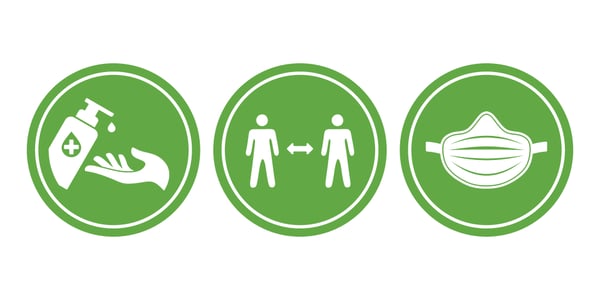
OSHA Recommendations
Employees are involving HR & OSHA more than usual on building comfort issues. Fear and anxiety are high with employees and customers expressing concern when buildings are warm, concluding something is wrong, or there is a safety issue at hand. Of course, wearing masks plays into comfort issues, but what guidance is OSHA giving?
OSHA has provided comprehensive medical information, control, and prevention recommendations by industry on its website. Relevant advice to retailers include:
- Hazard Recognition
- Risk exposure classifications–low, medium, high, very high factors
- Job duties that increase risk exposure
- How to identify specific workplace exposure risks
- Guidelines for Preparing Workplaces for COVID-19
- Steps employers can take to reduce risk exposure
- Information on workers living abroad or traveling internationally
- How to establish a safety and health program
- Control and Prevention Measures
- General hygiene practices to encourage
- Identifying and isolating suspected cases
- Environment cleaning and decontamination
- Worker training
- Increased worker susceptibility
- Personal protective equipment (PPE) consideration
- Retail Workers in High Customer-Volume Environments
- How to distance employees from customers
- Directing customers
- Safe work practices
EPA Recommendations
The EPA has issued joint guidance alongside the CDC on cleaning and disinfecting all spaces. They have also released information on maintaining or restoring water quality in buildings with low or no use, advice includes:
- Review and inspect plumbing configuration and water usage
- Reach out to the applicable water utility to check on water quality in the distribution area
- Maintain all water treatment and hot water systems
- Flush plumbing system regularly
- Maintain all non-drinking water systems in the building
-
Develop a water management plan as per the CDC's toolkit
State & Local COVID Advice
Retailers are strongly encouraged to check with both state and local authorities for any applicable standards or recommendations. State and local requirements, advice, and even resources fluctuate wildly, particularly when comparing densely populated cities like New York to rural areas.
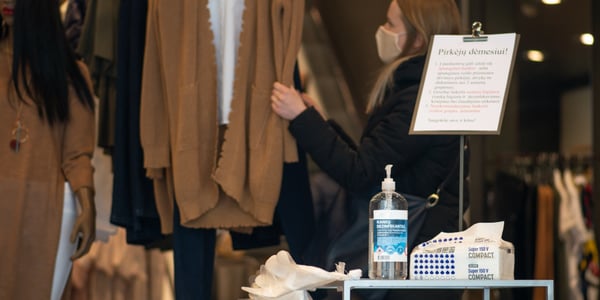
How to Manage and Automate
The best safety strategy to manage HVAC systems is to automate processes remotely through BAS systems. You want to control, be alerted to issues, and have at-a-glance views of how your locations perform.
Optimizing and monitoring air quality
-
Gauge air exchange rates
-
Add higher filtration to remove VOC gases
-
Leverage upper limit set-points to highest recommended settings
-
Ensures the unit fully optimizes "free cooling", which brings in 100% outdoor air and improves air quality.
- Reduce overnight "cool setback"
- Maintains a cooler environment for associates when they enter the building in the morning
- Lower set-points allow economizing overnight when nighttime temperatures drop below the economizer set-point.
- Increases the potential for indoor air exchange with minimum damper positions, when zones call for cooling at night
- Place fans to continuous mode
- Provides steady airflow during the day/night providing relief to associates and customers
- Reduce occupied cool set-points
- Provides a cooler environment for customers and employees

Building Analytics - How to Maintain a Healthy Building
Retail chains and operators have two choices in managing building systems to healthy standards and recommendations. They can either have adjustments made manually at the store level or use automated building systems. Manual reliance does not allow for peak performance, where the science of the building balances with outside influencers. And manual processes do not allow you to track and capture data for best management and compliance reporting.
Phoenix Energy Technologies provides best-in-class software that monitors and controls assets with minimal additional hardware. We turn stores, offices, classrooms, theaters, and more into smart buildings, by connecting, controlling, managing, and monitoring assets such as HVAC, lighting, refrigeration, industrial, and consumer-facing machines. Our systems alert, measure, and command to automatically correct or predict the need for service.
Monitor and manage with Phoenix Energy Technologies reporting
With employees more readily complaining to HR and OSHA right now over comfort issues, retailers need tools to manage and avoid comfort complaints. Phoenix Energy Technologies provides remote reporting across locations on zone temps, date temp readings, CO2 levels, unit efficiency, and humidity readings where sensors are available.
There are four specific Phoenix Energy Technologies reports we recommend for facility managers to stay on top of comfort while occupants continue to wear safety masks. We recommend our:
- Zone Temperature Performance Report - quickly highlights which locations are struggling with efficiency
- Comfort Mitigation Program Report - shows control fluctuations between normal and test sites
- HVAC Daily Diagnostic - provides a further snapshot of performance per location
- Call Tracker Report - lists complaint calls per location
1) Zone Temperature Performance Report
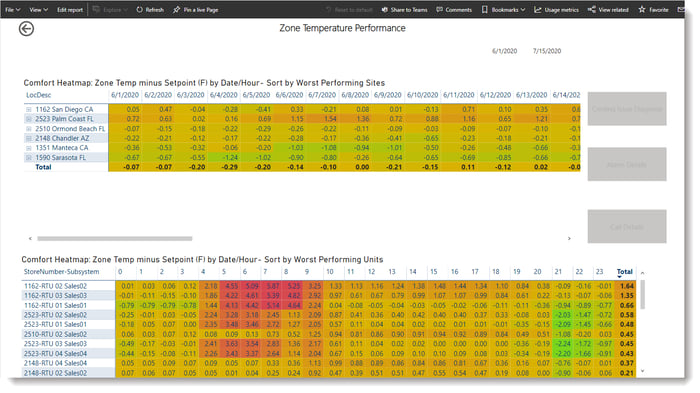 .
.
This report shows the average hourly zone temp, Delta T, and setpoint for a location throughout the day, showing morning startup, occupied times, and unoccupied times per site.
A large delta variance indicates that a different energy strategy is required. For example, if it takes several hours for units to cool the building after employees first enter, you may need to adjust setpoint to earlier to ensure occupant comfort.
2) Comfort Mitigation Program Report
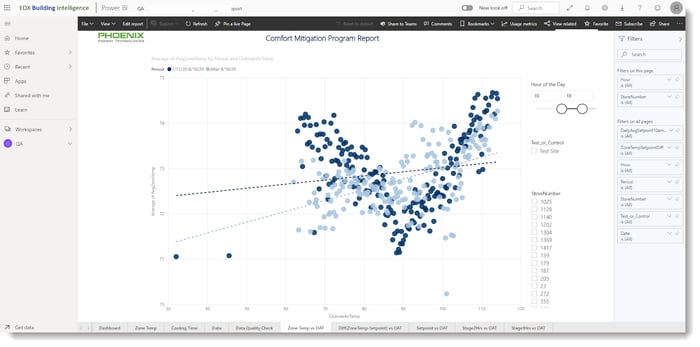
The Comfort Mitigation Program Report compares data between control sites and test sites to gauge if locations stay cooler during operating hours. This report allows you to demonstrate occupant comfort, which is useful to ensure mask-wearing occupants feel cooler. For retailers who seek to use energy strategies that go beyond blasting the air conditioner during the day, this reporting lets you test energy strategies and tweak as necessary.
This type of reporting also clarifies that the traditional approach to saving energy, which is to lower the occupied temperature, is not always the best strategy. Buildings retain thermal capacity. When building temperatures are adjusted at night as well as during the day, this preserves the cooling efforts made during day hours. Changing temperatures at night when it is cooler takes advantage of a "no heat load". The lower the setpoint is at night, the more potential for economizing during the night hours is present because the night hours are cooler. Under a strategy that takes into account thermal capacity, you shift consumption to an off-peak period.
3) HVAC Daily Diagnostic
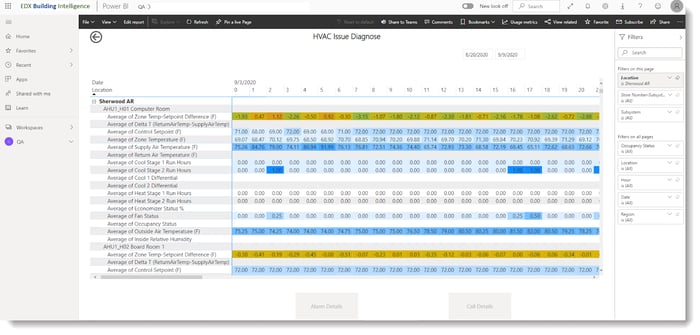
This report is a performance snapshot that shows the correlation between zone temperature against setpoint and the number of runtime hours. The report highlights morning startup recovery times to overnight temperatures, with the zone temp compared to setpoint deviation. This view helps facility managers mitigate deviation by staying on top of equipment, making sure units are operating correctly. Managing equipment efficiency helps preserve comfort.
4) Call Tracker Report
![]()
The Call Tracker Report shows the location, type of call, and temperature of the site at call time. This data can be stored for download for years and shows comfort improvements and records location feedback, among other data.
Data's role in HVAC operation
Building automation lets you maintain standards and best practices for running your HVAC systems across your locations. Automation and alerting allows you to stay on top of potential air quality concerns through the monitoring of:
- Temperature and humidity levels
- Indoor air quality via CO2, VOCs, and volume of fresh air brought in
- Pressurization of air ducts and spaces
- Air filtration performance and maintenance
How Phoenix Energy Technologies can help
Phoenix Energy Technologies helps building managers assess air conditioning units' condition by checking Delta T, CO2, and temperatures at all locations. We conduct audits through automated building control systems that keep you up to date to answer building occupant questions on air quality.
Phoenix Energy Technologies allows you to:
- Organize your stores into groups and prepare strategies by ASHRAE zones or other parameters of your choice.
- Develop multi-action strategies - cascading tactics to keep your curtailment on track.
- Set strategies at the system OR subsystem level, such as managing 25% of your RTUs every 15 minutes.
- Maintain zone temperature - set curtailment activities to cancel if the zone temperature gets too hot or too cold.
- View all of today’s demand events at a glance.
Please reach out to us to evaluate how we can assist you through managing, monitoring, and reporting on ventilation and air quality across your retail locations.


